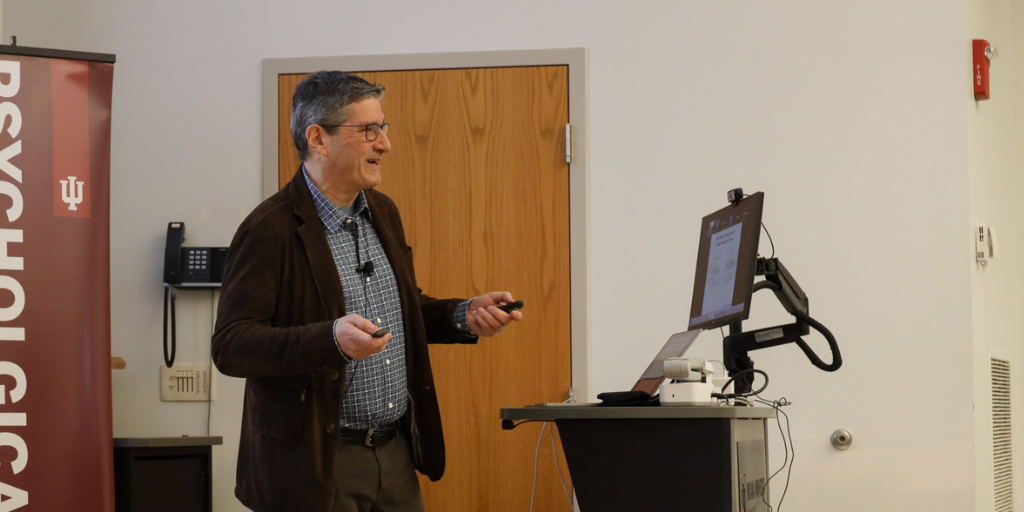“What does it mean to sleep like a baby?”
With that question Professor and Distinguished Chair Mark Blumberg of the University of Iowa kicked off this year’s Eliot S. Hearst Memorial Lecture, “Developing the sensorimotor system in our sleep: Implications for typical and atypical development.”
And whatever the phrase “sleeping like a baby” may have conjured in your mind before the lecture would not be quite the same by the end. In that sense, Blumberg more than matched the goal of the lecture series’ founders, Drs. Joseph Newman and Alida Evans, to challenge our preconceptions by bringing leading thinkers in psychological and brain sciences to present their ideas and interact with students.
Psychology, said Blumberg, has focused most of its attention on understanding adult sleep. “But,” he added, “we’re sort of missing the point when we do that, because we sleep the most when we’re young. There’s too much sleep involved in early development for us to ignore it.” Infants, he noted, spend about 16 out of 24 hours asleep and the qualities of this sleep change as babies age.
The question of why we sleep so much when we are young is one of the driving mysteries in the world of sleep and infant development. And one he continues to explore.
A curious feature of infant sleep
In a time-lapse video of a sleeping baby, Blumberg zooms in on a curious feature of infant sleep that has gained special prominence in his work: the pronounced twitching from one part of the body to another, from face to arms, legs, head, hands, and feet, a “full body experience” during sleep that begins even before birth.
Twenty years of studying this intriguing phenomenon has led him to an astonishing conclusion: that twitching is critical to the process by which we learn to use our bodies, enabling us to build internal models of the body and connect each body part to corresponding points in the central nervous system. As he explained, it’s like figuring out which switch controls which light on a vast and elaborate switchboard. And in this case, “activating the entire sensory-motor-neuro axis.”
Developmental trajectories, in humans and robots
Blumberg’s work has potentially groundbreaking implications for the study of both typical and atypical development. It may shed light on the origins of disorders such as autism, for example, which he points out is arguably associated with sleep problems and features of sleep linked to twitching. Blumberg is currently pursuing this line of inquiry in a five-year study which follows the kids in a neonatal intensive care unit through their first two years of life to look at the relationship between clinical outcomes and sleep during this timeframe. On yet another front, his work has influenced robotics, where integrating the mechanics of twitching has improved the way robots function.
A history of PBS mentorship
Blumberg’s ties to PBS span generations. As a postdoctoral researcher in the lab of PBS Professor Jeff Alberts from 1988-1992, Blumberg interacted with numerous developmental faculty, such as Linda Smith, Esther Thelen, Susan Jones and Meredith West, at an exhilarating time in PBS history.
A decade after his work at IU, Blumberg played a role in shaping another PBS scholar – Professor Tim Pleskac, a student of Blumberg who worked with him on his senior honors thesis as a University of Iowa undergraduate in the late 1990s.
“Mark has an uncanny ability to notice fundamental behaviors—things we all observe and think we understand—and then use rigorous science to uncover the mechanisms behind them,” Pleskac reflected. “His conclusions often challenge conventional wisdom, deepening our understanding of behavior and development. I found his work inspiring back then and I find it equally inspiring now.”
How the story of sleep evolved
As Alberts explained, soon after Blumberg arrived in Iowa, he began exploring questions of sleep. “He has a way of burrowing into questions, digging deep—and is a keen observer, trusting that if you allow yourself to be curious, you can uncover things that are meaningful.”
“That’s really the story that we heard in his lecture,” said Alberts. “Unfolding over 20 years, it was always a very novel and interesting story – though until recently it wasn’t always clear where it was going.”

 The College of Arts
The College of Arts